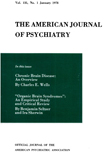Abstract
1. Heretofore it has been assumed that the manpower pool of the country was bottomless and induction screening was to a great extent designed to eliminate the "bad risks" and to minimize the incidence of breakdown. However, the experience of World War II suggests that the size and probable psychiatric composition of the total manpower pool are such that another large-scale mobilization will necessitate interest in marginal psychiatric groups. The evidence presented here favors the utilization of these groups in larger numbers than was the case in World War II, and a continuation of the trend away from reliance upon superficial induction screening and toward more effective utilization and prevention.
2. Since the major requirement of the armed forces is for logistic support, there is need for a more careful assessment of manpower requirements in terms of capacity to function at a wide array of particular jobs, rather than just in combat. The type of psychiatric examination that is possible at induction provides an insufficient basis for forecasting military performance and therefore cannot be relied upon to choose individuals for service; its value is confined to the elimination of only the more obviously inapt and the grossly ill. To have kept out of the Army in World War II all psychiatrically predisposed men would have cost an estimated 1,000,000 men who served without ever having been admitted to psychiatric care.
3. Those who required psychiatric care in the service, even if overtly neurotic at entry, appear to have paid their way as a group.
4. Although there is a high degree of correlation between the chance of breakdown and the degree of emotional impairment present prior to entry into service, this is also true of stress. In only 5% of the follow-up sample did breakdown occur without apparent stress, and in more than 80% of every personality group the major area of stress was a military one.
5. Groups devoid of significant psychiatric defect at entry contributed about 35% of all Army World War II admissions for all psychiatric diagnoses except psychosis, mental deficiency, and "for observation only, no disease found." In 1944 they contributed half of the admissions for psychoneurosis.
6. Within the period of modern psychiatry U. S. military operations have been preeminently offensive, overseas actions; in a defensive war at home it is possible that the psychiatric problem would be a smaller one.
7. Resistance to military stress generally, and to ground combat in particular, varies greatly with age, older men having much higher rates of admission for psychiatric Care.
8. The net effect of breakdown in service, as seen 5 years later at follow-up, is not as great as might be expected. There is relatively little change in those who were previously normal or overtly neurotic and a moderate worsening of the emotional health of those with personality disorders, neurotic traits, and suggestive neuroses. Except for those who seemed entirely normal at entry, combat seems to produce somewhat more disability than other forms of military stress.
9. Criteria for evaluating military performance seem badly needed.

